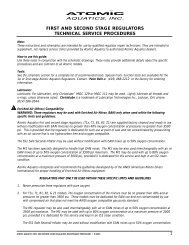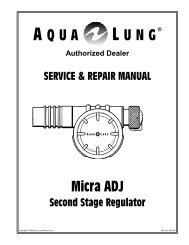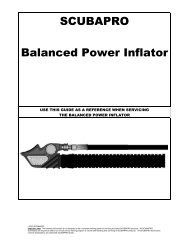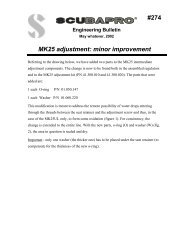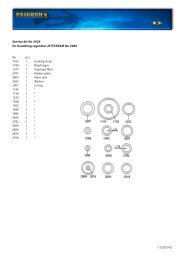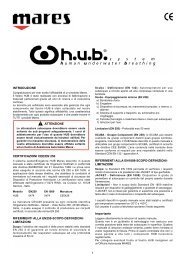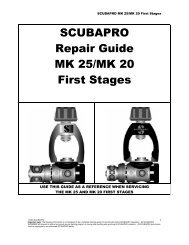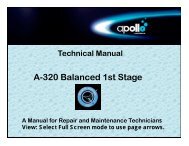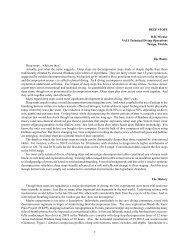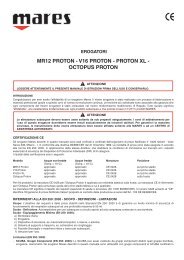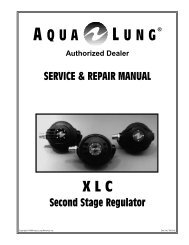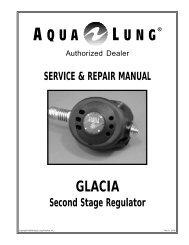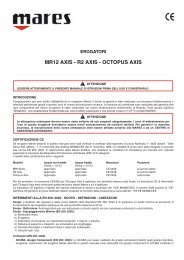Manual - Simply Scuba
Manual - Simply Scuba
Manual - Simply Scuba
- No tags were found...
You also want an ePaper? Increase the reach of your titles
YUMPU automatically turns print PDFs into web optimized ePapers that Google loves.
TABLE OF CONTENTS27Introduction . . . . . . . . . . . . . . . . . . . . . . . .page 26Main Components . . . . . . . . . . . . . . . . .page 261) FIRST STAGES . . . . . . . . . . . . . . . . . . . . . .page 273) USE AND MAINTENANCE . . . . . . . . . .page 491.1 MC7 Balanced Diaphragm 1st stage . . . . .page 301.2 Antifreeze Kit . . . . . . . . . . . . . . . . . . . . . . . . .page 311.3 AC10 Balanced Piston 1st stage . . . . . . . . .page 311.4 AC2 In-Line Piston 1st stage . . . . . . . . . . . .page 331.5 Performance . . . . . . . . . . . . . . . . . . . . . . . . . .page 353.1 Use of the SCUBA andRisk Assessment . . . . . . . . . . . . . . . . . . . . . .page 503.2 Checks Before Use . . . . . . . . . . . . . . . . . . . .page 503.3 Assembly of the Regulator on the Cylinder page 503.4 Disassembly of the RegulatorMaintenance and Storage . . . . . . . . . . . . . .page 51ENGLISH2) SECOND STAGES . . . . . . . . . . . . . . . . . .page 362.1 Second stages Ellipse . . . . . . . . . . . . . . . . . .page 372.2 Ellipse disassembly and maintenance . . . .page 392.3 Airtech adjustable balanced 2nd stage . . .page 412.4 XS2 2nd stage . . . . . . . . . . . . . . . . . . . . . . . .page 432.5 Performance . . . . . . . . . . . . . . . . . . . . . . . . . .page 474) TABLES . . . . . . . . . . . . . . . . . . . . . . . . . . . . .page 133
28IntroductionCongratulations! The product you have chosen is the result ofcontinuous research and development conducted at ourTechnical Centers, featuring the highest CRESSI-SUB performanceand reliability criteria. It’s high performance qualities willdeliver years of trouble free service.All Cressi-sub regulators are certified for use to a depth of 50 m(150ft) depth as well as for use in cold water, with temperaturesbelow 10° C, having passed the severe 4° C (+0 -2) test, asrequired by UNI EN 250:2000 (European) standards, in compliancewith EC Directive 89/686. This Directive sets the provisionsfor the marketing and the essential safety requirements forPersonal Protection Equipment (PPE).Main ComponentsRegulators reduce the operating pressure of the cylinders to theactual ambient pressure, thus, supplying the diver with breathableair. Regulators consist of a “first stage” for reducing cylinderpressure and a “second stage” for secondary pressure reductionto ambient pressure. The combination of the cylinder,valves, regulator and harness constitutes a SCUBA system,which stands for Self-Contained Underwater BreathingApparatus.This User <strong>Manual</strong> illustrates the different regulator models manufacturedby Cressi-sub. It provides easy-to-use information onthe performance and maintenance of Cressi-sub regulators. AllCressi-sub regulators are designed to be compatible with otherCressi-sub components.NOTICE: This User <strong>Manual</strong> is no substitute for proper divetraining! All Cressi-sub <strong>Scuba</strong> equipment should only be usedby properly trained divers who have attained a diving certificationfrom a qualified instructional agency. For your own safety,proper servicing of your Cressi-sub dive equipment shouldalways be done at an Authorized Cressi-sub Service Center. WARNING: CRESSI-SUB ASSUMES NORESPONSIBILITY FOR ANY MAINTENANCE WORKCARRIED OUT BY PERSONNEL NOT AUTHORIZEDBY CRESSI-SUB.The information supplied by the manufacturer shall contain a: WARNING: that SCUBA complyng with EN 250 are notintended for more than one user to breathe from at the sametime.The information supplied by the manufacturer shall contain a: WARNING: that if SCUBA are configured and used bymore than one diver at the same time, then the cold waterand breathing performance may not fulfil the requirements ofEN 250.
1.1 - MC7 Balanced Diaphragm 1 st stage1.2 - Antifreeze Kit1.3 - AC10 Balanced Piston 1 st stage1.4 - AC2 In-Line Piston 1 st stage
30 FIRST STAGES1.1 - MC7 Balanced Diaphragm 1 st stageThe MC7 Balanced Diaphragm 1 st stage ensures constant performanceunder all sport diving conditions. The unique feature ofthis light and compact balanced system is that it provides consistenthigh performance airflow at all tank pressures and at allsport diving depths. Intermediate pressure remains the same,regardless of tank pressure or depth. Generally, the performanceof regulators deteriorate as tank pressure is reduced or asthe diver descends to a deeper depth. This is not the case withthe MC7 regulator. Performance is maintained, regardless ofpressure and depth. This unique “hyper-balancing” featurewas made possible by an “on line” system and by an accurateinternal surface design. Regulator performance is consistentthroughout the dive, offering top performance at all stages of thedive, as well as during the important critical ascent phase.Within the 1 st stage is a flexible diaphragm (15) that both protectsand seals the internal mechanism, while transmitting water pressurechanges to the high pressure seat (8).For this reason, the MC7 BalancedDiaphragm 1st stage is a betterchoice for diving in water with a highcontent of suspended matter or dissolvedmineral salts. The MC7 balanceddiaphragm 1 st stage is recommendedfor cold water use (withwater temperatures below 10 °C),with the addition of an Antifreeze Kit(20K) (see chapter 1.2). The additionof the Antifreeze Kit ensures that the1 st stage is completely sealed, withfreezing related problems eliminated.MC7 balanced diaphragm first stagefeatures a compact, chrome-platedbrass body with internal componentsfig. 1made of stainless steel, chrome-plated brass, and thermoplasticresins. The first stage is supplied with 4 low pressure (LP) 3/8”ports, arranged at proper angles to avoid interference with otherconnected equipment, and 2 high pressure (HP) 7/16” ports with0.2 mm restricted airflow vents, allowing for maximum safety inthe event of accidental damage to the high pressure hose, thus,resulting in a potential rapid depletion of tank pressure. WARNING: It is necessary to connect either a pressuregauge or a pressure-measuring computer to one of the 1 stStage HP ports. Since cylinders do not feature a reservedevice, an underwater pressure gauge must to be connectedto the regulator 1 st Stage in order to monitor air consumptionwhile diving.Diving without a pressure gauge is dangerous since you cannotcheck air consumption, and should you suddenly run outof air while diving, you can put your life at risk.Air supply into the 1 st stage is protected by a cone shaped sinteredfilter (5K) which retains all impurities from the cylinder andthe valves.The 1 st stage is connected to the cylinder valves by means of aninternational YOKE CGA 850 connection using a newly designedbracket with an advanced engineering concept (2), or by meansof a DIN UNI EN 12209-1-2-3 (21K o 22K) threaded connection incompliance with UNI EN 250:2000 standards. DIN connectionsare recommended when cylinders with more than 200 bar (2900psi) working pressure are used.The adjusting and setting of the intermediate pressure of thisbalanced diaphragm first stage is easy, but requires the serviceof a properly certified technician. WARNING: The intermediate pressure should only beadjusted by Cressi-sub authorized centers. Changing pre-setvalues can affect the proper function of the regulator.
FIRST STAGES31The Cressi-sub MC7 Diaphragm regulator is a technicallyadvanced regulator made with the highest quality materials andworkmanship. It is designed to offer years of top performanceand reliability.1.2 - Antifreeze Kit WARNING: Proper training is required in order to safelydive in cold (less than 10°C) water. Before diving under theseconditions, Cressi-sub recommends that you attend a specialty,cold water course conducted by qualified instructors.The regulator should not be placed in water prior to use andthen exposed to the air (which is likely to be several degreesbelow zero). Do not operate the purge button, especiallywhen the Venturi knob (Dive / Pre Dive Switch) is in the “dive”position. If possible, keep the regulator in a warm place beforeuse.The Antifreeze Kit is used to seal off or waterproof the MC7Balanced diaphragm first stage, thus, preventing water fromentering. Additionally, it prevents water from coming in contactwith the diaphragm and the main spring, and a water-tight airchamber is created within the first stage, which acts as a thermalbarrier. In this way, problems related to contact with cold waterare avoided, especially at temperatures less than 10°C.Sold separately from the regulator, the Antifreeze Kit is easy toinstall. It features a metal (No 20K) cover with a siliconediaphragm inside. When sensing any ambient pressure change,the diaphragm flexes inward and transmits the movement overto the underlying disk. The latter unit, being in contact with themain diaphragm, acts as a transmission element and transmitspressure change information onto the diaphragm. The maindiaphragm protects and seals the inner system mechanism, andtransmits the information on water pressure changes to the highpressure seat (8K). WARNING: After having mounted the antifreeze kit, theMC7 Balanced Diaphragm 1st Stage must be reset. WARNING: The intermediate pressure should only beadjusted by Cressi-sub authorized centers. Changing pre-setvalues can affect the proper function of the regulator.1.3 - AC10 Balanced Piston 1 st stageFig. 2The AC10 Balanced Piston 1 st stage features a 90° anglebetween 1 st stage and air supply. It is constructed of a chromeplatedbrass body. All internal components are made of stainlesssteel and chrome-plated brass, with stainless steel springs andNBR O-rings.Many technical and aesthetic innovations make this first stagedifferent from the previous models and place it at the top of ourproduct line, while maintaining its features of high reliability anddurable construction.The Balanced Piston 1 st stage features a revolving turret (no. 5)with 5 intermediate pressure 3/8” ports, (one more than in theENGLISH
32 FIRST STAGESprevious versions), and all arranged to allow easy connection ofall accessories. Intermediate pressure ports have been madelarger in order to limit any pressure loss during regulator operationand ensure an adequate airflow under every condition of use.The intermediate pressure adjustment system (a unique featureof all Cressi-Sub regulators) has also been upgraded. WARNING: The intermediate pressure adjustmentsshould only be made by certified technicians or by Cressi-subauthorized centers. Changing pre-set values can affect theproper function of the regulator. WARNING: It is necessary to connect either a pressuregauge or a pressure-measuring computer to the 1st Stage HPport. Since cylinders do not feature a reserve device, anunderwater pressure gauge must to be connected to theregulator 1st Stage in order to monitor air consumption.Without a pressure gauge you cannot monitor air consumption,and should you suddenly run out of air while diving, youcan put your life at risk.The main regulator body features a number of technical innovationsof this balanced piston 1 st stage: an extrusion-proof retainer(17K) for the O-Ring inside the regulator case has beenadded. This new feature has been designed to further improvethe regulator performance.Special care was given to materials used and to the design ofeach component, aimed at preventing oxidation. For example, aspring protection capsule (no. 12) has been added to avoid anyspring-poppet contact. A new screw, locking the revolving turret(no. 9) has been designed with a larger airflow cross-section,and a lower head profile to minimize galvanic oxidation.Fig. 3Another very important feature of this regulator concerns maintenance,which is particularly easy and quick to perform due toits advanced design.Two high-pressure (HP) 7/16” ports are located on the main regulatorbody with 0.2 mm controlled air vent. In the event of accidentaldamage to the high-pressure hose, the flow of air fromthe tanks is controlled against rapid air depletion.fig. 4
FIRST STAGES33Air supply into the first stage is protected by a cone-shaped sinteredfilter (30K) which retains all impurities from the cylinder andthe valves.The first stage is connected to the cylinder valves by means of aninternational YOKE CGA 850 connection using a newly designedadvanced engineering concept bracket (31), or by means of aDIN UNI EN 12209-1-2-3 (21K o 22K) threaded connection incompliance with UNI EN 250:2000 standards. DIN connectionsare recommended when cylinders with more than 200 bar (2900psi) working pressure are used.In addition to these advancements, the balanced piston 1 ststage has been aesthetically improved with finishing details anda high-tech design. Its outstanding technically advanced constructionand simple mechanics insure superior performanceand ease of service for years.International (200÷300 bar) (2900÷4350 psi) DIN connectionsare interchangeable and easily replaced in a few minutes.Satin finish offers maximum surface protection, while contributingto the outstanding strength and reliability. The first stage ismanufactured with the finest materials and quality Cressi-subworkmanship.ENGLISH1.4 - AC2 In-Line Piston 1 st stageSmall, lightweight, simple, durable construction and easy maintenance;these are the features of this In-Line Piston 1st stagethat offers remarkably high performance compared to a balancedpiston model.Its compact and attractive design features 4 low-pressure 3/8”ports, arranged in pairs, with preset angles to allow for easy connectionwith accessory equipment. Intermediate pressure settingis easily performed by externally adjusting a unique revolvingnut.Inside, a cone shaped high capacity filter provides a filteringcapacity 200% higher than a standard flat filter.Airflow capacity reaches up to 2,100 liter/minute due to newlarger air ports, offering unequalled performance in this categoryof regulators.fig. 5
1.5 - Performance
351.5 - PerformanceBalanced diaphragm 1st stage MC7 regulatorWorking pressure (INT connection)0÷232 bar (0÷3365 psi)Working pressure (DIN connection)0÷300 bar (0÷4350 psi)Calibration pressure9.2÷9.6 bar (134÷140 psi)Air supply 3000 l/min (*)High pressure seats (HP) 2Low pressure seats (LP) 4(*) values measured at LP seat outlet with second stage connected and 200150 bar (29002175 psi) pressure in the cylinders.ENGLISHBalanced piston 1st stage AC10Working pressure (INT connection)0÷232 bar (0÷3365 psi)Working pressure (DIN connection)0÷300 bar (0÷4350 psi)Calibration pressure9.5÷10 bar (138 ÷ 146 psi)Air supply 2800 l/min (*)High pressure seats (HP) 2Low pressure seats (LP) 5(*) values measured at LP seat outlet with second stage connected and 200150 bar (29002175 psi) pressure in the cylinders.Unbalanced piston 1 st stage AC2Working pressure (INT connection)0÷232 bar (0÷3365 psi)Working pressure (DIN connection)0÷300 bar (0÷4350 psi)Calibration pressure9.0÷10 bar (128÷146 psi)Air supply 2100 l/min (*)High pressure seats (HP) 1Low pressure seats (LP) 4(*) values measured at LP seat outlet with second stage connected and 200150 bar (29002175 psi) pressure in the cylinders.
2.1 - Second stages Ellipse2.2 - Ellipse disassemblyand maintenance2.3 - Airtech adjustablebalaced 2 nd stage2.5 - XS2 2 nd stage
SECOND STAGES372.1 - Second stages Ellipsefig. 6fig. 7ENGLISHThe Ellipse second stage (in its various models) is a revolutionaryelliptical shaped lightweight (only 158 gr - the lightest of its class!)“downstream” regulator featuring a futuristic design.The regulator has a number of innovative features covered bydifferent patents.It is manufactured in several versions, which are different notonly because of their first stages but also because the “EllipseTitanium” version has several components and inserts made oftitanium, a material which shows advanced mechanical characteristics,and is incomparably light and resistant to corrosion.All regulators have the same mechanical components and functionalcharacteristics as well as the same cage made of a newelastic techno-polymer with excellent mechanical properties:therefore, from now on, the regulator will be described simply bycalling it “Ellipse”.Ellipse was designed to supply air “on demand” i.e. only whenthe diver inhales into the mouthpiece, creating a small vacuuminside the regulator. This vacuum, acts on the ellipitical shaped,variable-section diaphragm designed to have an increase in itsoperating surface, and to keep the breathing effort as low aspossible. This ensures performance which is similar to that ofmore expensive regulators.The diaphragm, which has been depressed inside the secondstage, causes the center plate to contact a variable-profile leverdesigned to optimize and dramatically reduce the friction resultingfrom the contact between lever and diaphragm, concentratingit into a single point of the plate. This minimizes frictionbetween the demand lever and the diaphragm plate. To carryout this task, the special (patented) lever profile is assisted by aswinging motion of the piston.When activated, the lever opens the regulation valve. Air comesout of the (adjustable) valve nozzle when the mechanism opensflows into the injector which carries it directly into the mouthpiece.The air is accelerated due to the Venturi effect whichcauses a depression inside the second stage body. To avoid freeflow the injector portion directs a small opposite counterflow ofair toward the diaphragm.A “valve-guiding” bushing made of a thermoplastic rubber,placed inside the valve, performs the following two functions:guides the spindle motion, reducing friction between themechanical elements each time the valve opens as well as toprotect the regulator in case the valve starts freezing at its mostcrucial point. In this way, all the air required by the diver is only fedinside the injector, thus avoiding any air loss in the spindle/valvehousingcoupling.
38 SECOND STAGESnot used, otherwise one of the following situations may causean even strong constant flow producing high air consumption:an accidental impact, the regulator falling into water, pressingthe manual regulation purge button when the regulator is notinside the mouth or suddenly taking the regulator out of themouth.The dive (+) position must only be used while diving and onlywhen the regulator is inside the mouth.fig. 8DIVEPRE-DIVEWhen the air flow supplied into the injector and directed to themouthpiece becomes dense, it undergoes, as we mentionedabove, an acceleration known as Venturi effect. The consequentvacuum which is created inside the second stage, keeps thediaphragm depressed, thus virtually reducing the breathingeffort to zero.The Venturi effect immediately stops as soon as the diver stopsbreathing. The diaphragm returns to its normal position, the levercomes up again pushed by its spring, and the nozzle is closed bythe piston.In order to optimize the Venturi effect, Ellipse is provided with anew and ergonomic flow deflector which has two operatingpositions, clearly shown by the symbols on the regulator housing:“-” (“pre-dive” position) and “+”(“dive” position). At the firstposition, a flow limiting device placed in the mouthpiece inletstarts operating and inhibits the Venturi effect, preventing a constantflow. At the “+” position, the Venturi effect works at its best,increasing the air flow supplied to the regulator to the maximumlevel. WARNING: Remember to always set the lever of the flowlimiting device to the pre-dive (-) position when the regulator isfig. 9When the diver exhales, he/she causes the pressure toincrease inside the regulator second stage, which opens theexhaust valve. The exhaust valve, has a large cone shape. Thenewly designed exhaust tee is formed directly from the secondstage, thus creating an extremely compact assembly with anextraordinary design. Air fed to the sides of the exhaust valveseat, in the regulator second stage, protects the valve againstwater turbulence which might lift it when the second stageinside is depressurized, causing flooding. Moreover, a specialbulkhead on the second stage exhaust tee center line suitablypushes the exhaust valve on its middle section, ensuring a balancedopening.
SECOND STAGES39in order not to jeopardize the correct operation of the regulator.Cressi-sub assumes no responsibility for any operationcarried out by personnel not authorized by Cressi-sub.The 2nd stage is connected to one of the 3/8” LP outlets of the1st stage through an intermediate pressure, high flow capacityhose.Cressi-sub Ellipse is a downstream regulator design.This means that in the event of over-pressurization of the 1ststage, excess air will be safely released through the 2nd stage.Cressi-sub Ellipse complies with 89/686/CEE Directive of21/12/1989, having been tested and certified by Genova-basedTest Board No. 0474 RINA, through tests complying with UNI EN250:2000 standard which sets forth the requirements concerning3rd-class Individual Safety Devices (DPI), and consequentlybears the EC marking followed by the Certification Board identification(0474) in compliance with Art. 11B DE 89/686/CEE.2.2 - Ellipse disassembly and maintenancefig. 10The Ellipse regulator has been designed to ensure easy andquick servicing by authorized repair technicians. WARNING: The 2nd stage must ONLY be opened, disassembledand calibrated at Cressi-sub authorized centres andthe calibration values can NOT be and must NOT be changedUsing the same socket wrench supplied with the regulator todisassemble the first stage HP and LP little plugs, you can openand disassemble the 2nd stage, reaching directly its internalmechanical components. This extraordinary characteristic,which is unique in this field and patented, allows to open the tankin a very easy and quick way in order to clean it, and to check forthe perfect operation of the various components.In the different steps shown on the previous figures, the cap andthe middle compartment of the exhaust conveyor appear asmechanically constrained to each other. The unusual (patented)“cam-lock” locking system, allows to open and close the tankvery quickly, locking both the cap and the diaphragm with highefficiency and accuracy.Opening and closing a regulator has never been so easy, and sosafe, too!!!In order to make test, overhaul and setup easier, all the mechanicalcomponents of the second stage can be fully removed fromthe tank in a few seconds, without changing its calibration. In thisway, during the periodic maintenance works, any worn part canbe disassembled and replaced after all the mechanical componentsof the regulator have been removed, thus allowingextraordinary easy operations.To remove the mechanical components from the tank, asshown on the following figure, just loose the lateral lock nut andremove the two cone-shaped locking pins. The mechanicalcomponents can then be removed as a whole, i.e. without havingto remove any single component, and especially withoutchanging the regulator calibration: a unique characteristic in thisfield which provides numerous advantages.ENGLISH
40 SECOND STAGESfig. 11fig. 13fig. 12fig. 14
SECOND STAGES41To assemble the regulator, follow the disassembly steps in theopposite order, just paying special attention when closing theregulator. As you can see from the following pictures, once themechanical components have been fitted into the regulator, firstplace the regulation diaphragm into its housing, then fit the cap,made out of a special semirigid thermal rubber belonging to thelast generation of technical polymers, and finally close the regulatormaking sure that the tooth in the cap bottom correctlyslides into the appropriate tank seat, as shown on figure B.figure Afigure B2.3 - Airtech Adjustable Balanced 2 nd Stagefig. 15ENGLISHfigure Cfigure DThe balanced second stage supplies air to the diver on demand.As the diver inhales, a slight vacuum is generated in the secondstage causing the diaphragm (no.20) to come in contact with alow friction demand lever disk, located on a demand lever (no.16K). As the vacuum is increased, air flows from the air supplyorifice. Airtech CE 2 nd Stage features a unique, pneumaticallybalanced poppet (11K) with a small hole across its longitudinalaxis (fig. 16). The air coming from the 1 st stage flows across thissmall hole and reaches a small balancing chamber located at theend of the poppet (11K). The air inside this chamber exerts pressure(which varies with depth) on the poppet. The poppet ispushed toward the orifice, closing it (4K) toward the air inlet fromthe 1st stage. Since the forces acting on the orifices opening andclosing are balanced, a light rated spring (12) is used, whichallows for a smoother opening of the orifice. This results in analmost effortless inhalation effort.The air flowing through the orifice opens the seat, which is locatedat the end of the poppet.(11K). This force is counteracted bythe sum of the spring and the air force. The air has now entered
42 SECOND STAGESthe balancing chamber. Airtech Balanced Adjustable 2 nd Stagealso allows you to adjust the breathing effort. By turning the outsideknob along the direction of the arrows, you can adjust thelevel of resistance to inhalation by changing the poppet springload. By screwing the knob in (clockwise), the resistance toinhalation is increased; by unscrewing it (counterclockwise), theresistance to inhalation is lowered. Two O-rings are utilized in theadjustment system for protection of the adjustment mechanismagainst water leaks. These properly lubricated O-rings protectthe mechanism thread against oxidation, which could harden andrestrict the adjustment knob rotation. With proper regular maintenance,the adjusting knob will always rotates smoothly, allowingfor accurate and smooth adjustment of the inhalation effort.fig. 16The adjustable orifice is located inside the housing. When themechanism is open, air enters the injector (19) and flows into themouthpiece. Air flows across the diaphragm-balancing hole,which is aligned with the diaphragm. As a result of this design, thesecond stage vacuum is controlled, not allowing the diaphragmto be forced on the demand lever, resulting in a free flow.When a significant amount of air flows through the injector intothe mouthpiece, a vacuum is formed inside the regulator casedue to increased air speed. This high flow of air is called a Venturieffect. Venturi effect keeps the diaphragm drawn down and significantlyreduces the inhalation effort.When breathing stops, the Venturi effect is immediately disconnected;the diaphragm resumes its original position, the lever,pushed by its spring force is raised, and the orifice is closed bythe poppet.In order to maximize this Venturi effect, Airtech CE is fitted with aflow control vane (7K) with two operating positions, clearly indicatedin the graduated scale on the regulator case asPre-dive “-” and Dive “+”. When the vane is set to the pre-diveposition, a flow limiter inside the mouthpiece is actuated, whichlimits the Venturi effect and prevents free-flowing. When in “+”position, the Venturi effect is maximized, and the airflow to theregulator is increased to the highest level. WARNING: The small flow control lever vane must alwaysbe kept in the pre-dive (-) position when the regulator is not inuse. In case of an accidental impact when the regulator isbeing submerged, or in the event of the purge button beingdepressed with the regulator out of the divers mouth, the regulatormay start an excessive flow (free flow), depleting a significantamount of air from the cylinders. The dive (+) positionmust exclusively be used for diving at depth and only when themouthpiece is in the mouth.DIVEPRE-DIVEfig. 17
SECOND STAGES43fig. 18ENGLISHWhen the diver exhales, the pressure inside the regulator caseincreases and the exhaust valve opens (17). The AirTech exhausttee has been improved over previous exhaust tees to improveits exhalation effort. The exhaust tee (9K) directs exhausted airto the side of the divers head, protecting the valve against waterturbulence, which could open it while the valve body is not underpressure.The 2nd stage is connected to one of the 3/8” ports of the 1ststage through a flexible intermediate pressure hose.All Cressi-sub second-stage regulators feature a safety, downstreamvalve so that in case of sudden increase of intermediatepressure, the second stage will automatically open, relievingexcessive over pressure. In the unlikely event of a first stage malfunction,resulting in an over pressure situation, the secondstage will relieve excess pressure, allowing for the continued useof the second stage.Airtech CE case is manufactured with new, techno-polymermaterials featuring outstanding mechanical properties and anattractive look. Additionally, the cover features a special lightweightcorrosion resistant titanium insert supported by lockingrings. CAD design and in-depth studies of water flow across theregulator case have led to further optimization and enhancementof the performance level of CRESSI-SUB regulators.2.5 - XS2 2nd stagefig. 19The second stage supplies air on demand, namely only when thediver inhales through the mouthpiece, thus generating a slight airvacuum inside the regulator. This vacuum is minimum for effortlessbreathing, but enough to operate the diaphragm (19) whichis sucked inward, thus moving the center disk (coated with a specialantifriction material) into contact with the small lever (9). At thispoint the lever is brought down and opens the air supply valve.fig. 20
44SECOND STAGESThe XS2 orifice consists of a new modular plastic and chromeplatedbrass poppet (22K). It is perfectly interchangeable with allthe previous models of the XS range (5). On one side, the poppetis connected to the small lever, while on the other side ithouses, in a special housing, a newly designed and thicker rubberseat. This seat closes the new adjustable orifice, throughwhich air flows at a pressure by 9.0÷10 (128÷146 psi) bar higherthan ambient pressure.The air flowing through the orifice (21K) pushes the seat which iscounteracted by the poppet spring (7).Therefore the new poppet sort of ”floats” under the push of theincoming air and the spring. However, since the spring force isgreater, the orifice will be kept tightly closed.The adjustable orifice is housed inside the housing. When themechanism is open, the air is pushed through the injector (10)and directly sent into the mouthpiece. When a significantamount of air is flowing through the injector into the mouthpiece,a vacuum is formed inside the regulator case due to increasedair speed. This is called Venturi effect, which keeps thediaphragm down and significantly reduces the inhalation effort.When breathing stops, the Venturi effect is immediately discontinued;the diaphragm resumes its original position, the lever,pushed by its spring, is raised and the orifice is closed by thepoppet.In order to maximize this Venturi effect, XS2 CE is fitted with aflow control vane (12K) with two operating positions, as clearlyindicated in the graduated scale on the regulator case :pre-dive “-” and dive “+”. When the device is set on the first position,a flow limiter inside the mouthpiece hose is actuated whichlimits the Venturi effect, and prevents free-flowing. When in “+”position, the Venturi effect is maximized, and the air flow to theregulator is increased to the highest level. Warning: the small lever of the flow control vane mustalways be kept in pre-dive (-) position when you are not usingthe regulator. Otherwise in case of accidental impact, whenthe regulator is placed in water, when pressure is exerted onthe manual air supply button and the regulator is not in themouth, or even when suddenly taking the regulator out of yourmouth, the regulator may even violently start to free flow withsignificant air consumption.The dive (+) position must exclusively be used for diving atdepth and only when the mouthpiece is in the mouth.DIVEPRE-DIVEfig. 21When the diver exhales, the pressure inside the regulator case israised and the exhaust valve opened (18). This is a new taperedangled design valve with a greater diameter to let the air out. Theexhaust tie (14K) conveys the air at the side of the head protectingthe valve against water turbulence which could open it whenthe valve body is not under pressure, flooding it.The 2nd stage is connected to one of the 3/8” seats of the 1ststage through a flexible medium pressure and high capacityhose.All Cressi-sub second -stage regulators feature a down-streamtype valve so that in case the 1st stage calibration is lost or thereis a sudden intermediate pressure peak, the valve will openautomatically.This means that any excessive pressure flowing to the 2 ndstage may cause the regulator to free flow but never to getstuck.XS2 CE case is manufactured with new technopolymer materi-
SECOND STAGES45als offering outstanding mechanical properties and an extremelyattractive and aggressive look.CAD design and in-depth studies of water flows inside the frontof the regulator case have led to a further optimization andenhancement of the already very high performance level ofCRESSI-SUB regulators, together with their user-friendly andeasy maintenance features.Servicing in particular, has been made easier with the introductionof a side plug (20K) and related OR. Warning: Servicing must be carried out by Cressi-subauthorized centers only. Changing pre-set values can affectthe proper function of the regulator.ENGLISHAll internal components are in chrome-plated brass, stainlesssteel, and acetal resin construction. Springs are manufactured inharmonic stainless steel, diaphragms in silicon, O-rings and themouthpiece in allergy-free and comfortable silicon.
2.6 - Performance
472.5 - Performance2nd stage Ellipse titaniumWorking pressureINT: 0÷232 bar (0÷3365 psi); DIN: 0÷300 bar (0÷4350 psi)Calibration pressureMC7: 9.2÷9.6 bar (134÷140 psi);Average inhale effort (*)4 mbarAverage exhale effort (*)11 mbarAverage breathing work (*)0,9 J/lAverage air supply1600 l/minWeight (without hose)158 gr(*) Values measured in compliance with UNI EN 250:2000 standards.ENGLISH2nd stage Ellipse pistonWorking pressureINT: 0÷232 bar (0÷3365 psi); DIN 0÷300 bar (0÷4350 psi)Calibration pressureAC10: 9.5÷10 bar (138÷146 psi)Average inhale effort (*)5 mbarAverage exhale effort (*)11 mbarAverage breathing work (*)1 J/lAverage air supply1500 l/minWeight (without hose)160 gr(*) Values measured in compliance with UNI EN 250:2000 standards.2nd stage EllipseWorking pressureINT: 0÷232 bar (0÷3365 psi); DIN 0÷300 bar (0÷4350 psi)Calibration pressureAC2: 9.0÷10 bar (128÷146 psi)Average inhale effort (*)5,5 mbarAverage exhale effort (*)11 mbarAverage breathing work (*)1,1 J/lAverage air supply1450 l/minWeight (without hose)166 gr(*) Values measured in compliance with UNI EN 250:2000 standards.
48PerformanceAdjustable balanced 2nd stage AirtechWorking pressureINT: 0÷232 bar (0÷3365 psi); DIN 0÷300 bar (0÷4350 psi)Calibration pressureMC7: 9.2÷9.6 bar (134÷140 psi); AC10: 9.5÷10 bar (138÷146 psi)Average inhale effort (*)3 mbarAverage exhale effort (*)13 mbarAverage breathing work (*)0,9 J/lAverage air supply1700 l/minWeight (without hose)260 gr(*) Values measured in compliance with UNI EN 250:2000 standards.2 nd stage XS2Working pressureINT: 0÷232 bar (0÷3365 psi); DIN: 0÷300 bar (0÷4350 psi)Calibration pressureAC2: 9.0÷10 bar (128÷146 psi)Average inhale effort (*)10 mbarAverage exhale effort (*)13 mbarAverage breathing work (*)1,4 J/lAverage air supply1050 l/minWeight (without hose)200 gr(*) Values measured in compliance with UNI EN 250:2000 standards.
49 SECOND STAGES3 - Use and Maintenance
503.1 - Use of the SCUBA and Risk AssessmentBefore using any <strong>Scuba</strong> diving equipment, you should completea proper diving course.Do not attempt to dive if weather is bad or your physical conditionis inadequate.Always watch out for underwater currents, rough sea, extremelycold water and low visibility.If you are suffering from emotional and physical stress, baddigestion, or if you lack training, diving can become dangerous.The safety risk of diving is greater if you have not gone diving fora long period of time, as your skill level has diminished.All Cressi-sub regulators are manufactured with first quality anticorrosionmaterials for use in total safety.All open circuit air regulators are designed for use down to 50 m(150ft) depth, in compliance with UNI EN 250:2000. We recommendnot exceeding 40 m (120ft) of depth for recreational diving.3.2 - Checks Before UseAlways check your cylinder pressure before entering the water.Test the regulator by pressing the purge button repeatedly tomake sure that air is flowing properly. Holding the mouthpiecebetween your teeth, inhale and exhale deeply to check if theregulator and the exhaust valves are working well. Additionally,check your octopus in the same manor.Check for air leaks at connections, hoses or leaking from the regulator. Warning: First check your regulator out of the water, bydepressing the manual outlet button repeatedly, in order tocheck the regular air outlet; then, wear your mouthpiece andmake some deep inspirations and expirations, in order to checkits perfect working (not for use in cold water < 10°C/< 50°F).The same must be done on the surface of the water, beforeplunging, wearing your mouthpiece and deeply inspiring andexpiring, in order to check its perfect working. Warning: When the regulator has been assembled on thecylinder, the equipment has to be laid horizontally to preventaccidental falls from causing damage to components or injuryto people.3.3 - Assembly of the Regulator on the CylinderBefore assembling the regulator, make sure that the cylinder hasbeen filled with compressed air at a proper working pressure.Use a suitable compressor able to supply breathable air in compliancewith UNI EN 12021. Warning: Always remember to check the cylinder valve O-ring. If it shows cuts, scratches or abrasions, replace it. Even ifit is intact, it has to be replaced every 3 months because it isconstantly exposed to the cylinder high pressure and to weathering.It is advisable to only use Cressi-sub original spare parts.The instructions indicated below must be followed for 1st Stagewith yoke connections:Unscrew the yoke screw, remove the dust cap and place itagainst the valve outlet, after making sure that the 2nd Stage ison the suitable side.Tighten the yoke screw to connect the 1st Stage. Do not overtighten.Open the cylinder valve counterclockwise and keep the 2ndStage purge button pressed until the air starts flowing. Releasethe button and open the cylinder valve completely.In order not to damage the thread, it is advisable to turn the valve1/4 of a turn clockwise.The assembly of the 1st Stage with DIN connection is not verydifferent from the procedure described above. In this case, theconnection must be screwed directly on the valve outlet withoutover-tightening.When using a second independent regulator, connect it to theadditional valve outlet following the above instructions.
513.4 - Disassembly of the RegulatorMaintenance and StorageAfter diving, turn the cylinder valve clockwise until it is shut off.Press the manual purge button and let out the air from the hosesand connections. Disassemble the 1st Stage by unscrewing theyoke counterclockwise. Cover the sintered filter with your fingerand blow off all water from inside the dust cap. Place the dustcap on the 1st Stage air outlet and hold it there by tightening theyoke screw. Make sure that the dust cap O-ring is in place.Always rinse your Cressi-sub regulator with fresh water aftereach dive. Let water flow into 1st and 2nd Stage orifices, but donot press the manual purge button to keep water from flowinginto the hoses and, therefore, into the 1st Stage.Allow the regulator to dry prior to storage. Make sure the hosesare stored in a proper way to avoid acute folds.Cressi-sub regulators have to be serviced on a yearly basis ormore often according to use.ENGLISH Warning: Regulators should be serviced by Cressi-subcertified repair technicians or at a Cressi-sub authorized repaircenters using only original spare parts. Non-certified technicianscan jeopardize the diver’s life. Cressi-sub shall not beheld liable for maintenance or adjustments made by not dulyauthorized or trained staff.If the regulator is used by more than one person, it is advisableto disinfect it for 2 to 3 minutes in a 2% Stereamine G water solutionor other similar pharmacy products.All regulators are in compliance with UNI EN 250:2000 andtherefore, they bear the CE mark followed by the year of manufacturingand the certifying body identification number (0474).
4 - Tavole4 - Tables4 - Tableaux4 - Zeichnungen4 - Cuadros
Primi StadiFirst StagesPremiers EtagesErste StufenPrimeras Etapas
1º Stadio a Pistone Bilanciato AC10 / Balanced Piston 1 st Stage AC10Ed./IssueA/07AC10/2N° Tav./Rev.POS. CODICE / CODE1K HZ 730022 Nero1K HZ 730225 Giallo2 HZ 7700903 HZ 7301084 HZ 7301065 HZ 7700916 HZ 7000957K HZ 7700898 HZ 7700879 HZ 77008810 HZ 73510811 HZ 73513612 HZ 73513513 HZ 70009714 HZ 73513215 HZ 73513116 HZ 77008617K HZ 77008518 HZ 77008419 HZ 73012720 HZ 73013221 HZ 73512822 HZ 73513823 HZ 73512924 HZ 77008225 HZ 77008126 HZ 73512727 HZ 73512628 HZ 70008829 HZ 73011430K HZ 73018831 HZ 77008032 HZ 73002733K HZ 735162 (DIN 200 bar)34K HZ 735163 (DIN 300 bar)35K HZ 735197 (SET ORDIN 200-300 bar)36 HZ 73515437 HZ 73517038K HZ 735050 INT(kit Revisione/Maintenance Kit)38K HZ 735051 DIN 200 bar(kit Revisione/Maintenance Kit)38K HZ 735052 DIN 300 bar(kit Revisione/Maintenance Kit)39K HZ 800090
POS. CODICE / CODE1 HZ 7300272 HZ 7700803K HZ 8000904 HZ 8000895K HZ 8000886K HZ 80008726K= HZ 800069 7 HZ 800086{8 HZ 8000859 HZ 80008410 HZ 73012711 HZ 73013212 HZ 73010613 HZ 73010814K HZ 80008315 HZ 80008216 HZ 80008117 HZ 80008018K HZ 80007919 HZ 80007820K HZ 800050kit Antifreeze21K HZ 800076kit DIN 200 bar22K HZ 800075kit DIN 300 bar23K HZ 800074 INT(kit Revisione/Maintenance Kit)23K HZ 800071 DIN 200 bar(kit Revisione/Maintenance Kit)23K HZ 800070 DIN 300 bar(kit Revisione/Maintenance Kit)24 HZ 80007325K HZ 800072(kit OR DIN 200-300 bar)1º Stadio a Membrana Bilanciata MC7 / Balanced Diaphragm 1 st Stage MC7Ed./IssueA/07MC7/3N° Tav./Rev.
INTERCAMBIABILITÀ VALVOLE HP MC7 - MC7 HP VALVES INTER-CHANGEABILITY ATTENZIONE la valvola A, presente sui modelliMC7 prodotti fino al 2003(aventi finitura del corpo SATINATA come fig. 1) èfuori produzione! Pertanto, durante lamanutenzione ordinaria di questo modello,occorre sostituire tutti i componenti della valvola Acon tutti quelli che compongono la valvola Bdi attuale produzione (cod. 26K=HZ 800069).I modelli MC7 dotati di valvola B si riconosconoper la finitura del corpo LUCIDA (come fig.2). ATTENTION la soupape A, présente sur lesmodèles MC7 réalisés jusqu’en 2003,(avec finition du corps SATINÉE, comme dans fig. 1)est hors production! Par conséquent, pendantl’entretien ordinaire de ce modèle, il faut remplacertous les composants de la soupape A par tousceux qui constituent la soupape B actuellement enproduction (code 26K=HZ 800069).On peut aisément reconnaître les modèles MC7équipés de soupape B, grâce à la finition du corpsBRILLANTE (comme dans fig.2). WARNING The A valve on MC 7 models(produced until 2003 – showing satin finishedbody, as in image 1) is off production! By ordinarymaintenance of this model, you have therefore toreplace every component of the A valve withall those composing the B valve being produced atpresent (code 26K=HZ 800069). MC7 modelsequipped with the B valve have got polished body(as in image 2). ACHTUNG In die vor 2003 produziertenMC7-Modelle (mit MATTER Gehäuseoberfläche,wie in Abb. 1 gezeigt) ist das Ventil A eingebaut,das inzwischen nicht mehr hergestellt wird !Aus diesem Grund müssen bei der ordentlichenWartung dieses Modells alle Komponenten desVentils A komplett durch die Komponenten desaktuell verwendeten Ventils B ersetzt werden(Art. Nr. 26K=HZ 800069). Die MC7-Modelle miteingebautem Ventil B sind an der GLATTENGehäuseoberfläche erkennbar (siehe Abb. 2).fig. 1 ATENCIÓN ¡la válvula A, presente en los modelos MC7 producidos hasta 2003, y con el acabado delcuerpo SATINADO como en la fig. 1, ya no está en producción! Por lo tanto, durante el mantenimientoordinario de este modelo, hay que sustituir todos los componentes de la válvula A con todos los quecomponen la válvula B actualmente en producción (cód. 26K=HZ 800069). Los modelos MC7 dotadoscon válvula B se reconocen por el acabado del cuerpo BRILLANTE (como en la fig.2).fig. 226K = HZ 800069B2003A
POS.CODICE / CODE1º Stadio a Pistone non Bilanciato AC2 / Unbalanced Piston 1 st Stage AC2Ed./IssueA/07AC2/2N° Tav./Rev.1 HZ 7300272 HZ 7000893K HZ 7301884K HZ 8000905 HZ 7301146 HZ 7301517 HZ 7351268 HZ 7301529K HZ 73015310 HZ 73010611 HZ 73010812 HZ 73012713 HZ 73013214 HZ 73015415 HZ 73010516 HZ 73010417 HZ 73015518 HZ 73015619 HZ 73510820 HZ 73015721 HZ 73015822K HZ 730222 Nero22K HZ 730225 Giallo23K HZ 735158(DIN 200 bar)24K HZ 735157(DIN 300 bar)25 HZ 73515426K HZ 735195 200 bar26K HZ 735196 300 bar27 HZ 73015928K HZ 730150 INT(kit Revisione/Maintenance Kit)28K HZ 730148 DIN 200 bar(kit Revisione/Maintenance Kit)28K HZ 730149 DIN 300 bar(kit Revisione/Maintenance Kit)29 HZ 73022430 HZ 735170 (TAPPOPROTEZIONE DIN)31 HZ 730160
Secondi StadiSecond StagesDeuxiemes EtagesZweite StufenSegundas Etapas
POS. CODICE / CODE1 HZ 8100602 HZ 8100953 HZ 8100944 HZ 8100935 HZ 8100926 HZ 7420137 HZ 8100918 HZ 8100909K HZ 81008910 HZ 73020711K HZ 81008812 HZ 81008713 HZ 81008614 HZ 81008515K HZ 74609416 HZ 81008417 HZ 81008318 HZ 81008219 HZ 81008120 HZ 81008021K HZ 81007922 HZ 81007823K HZ 81007724 HZ 81007625 HZ 81006126 HZ 81007427 HZ 81007328 HZ 81007229 HZ 81006230 HZ 81007031 HZ 81006932K HZ 81006833 HZ 79009434 HZ 73020235K HZ 810067(kit Revisione/Maintenance Kit)2º Stadio Ellipse titanium / 2 nd Stage Ellipse titaniumEd./IssueB/04ELLT/2N° Tav./Rev.
2º Stadio Ellipse Piston / 2 nd Stage Ellipse PistonEd./IssueA/05ELLPT/1N° Tav./Rev.POS. CODICE / CODE1 HZ 8100962 HZ 8100953 HZ 8100944 HZ 8100935 HZ 8100926 HZ 7420137 HZ 8100918 HZ 8100909K HZ 81008910 HZ 73020711K HZ 81008812 HZ 81008713 HZ 81008614 HZ 81008515K HZ 74609416 HZ 81008417 HZ 81008318 HZ 81008219 HZ 81008120 HZ 81008021K HZ 81007922 HZ 81007823K HZ 81007724 HZ 81007625 HZ 81007526 HZ 81007427 HZ 81007328 HZ 81007229 HZ 81006330 HZ 81006431 HZ 81006932K HZ 81006833 HZ 79009434 HZ 73020235K HZ 810067(kit Revisione/Maintenance Kit)
2º Stadio Ellipse / 2 nd Stage EllipseEd./IssueB/04ELL/2N° Tav./Rev.POS. CODICE / CODE1 HZ 8100962 HZ 8100953 HZ 8100944 HZ 8100935 HZ 8100926 HZ 7420137 HZ 8100918 HZ 8100909K HZ 81008910 HZ 73020711K HZ 81008812 HZ 81008713 HZ 81008614 HZ 81008515K HZ 74609416 HZ 81008417 HZ 81008318 HZ 81008219 HZ 81008120 HZ 81008021K HZ 81007922 HZ 81007823K HZ 81007724 HZ 81007625 HZ 81007526 HZ 81007427 HZ 81007328 HZ 81007229 HZ 81007130 HZ 81007031 HZ 81006932K HZ 81006833 HZ 79009434 HZ 73020235K HZ 810067(kit Revisione/Maintenance Kit)
POS. CODICE / CODE1K HZ 7950902K HZ 770056 NeroHZ 770056 Giallo3 HZ 7302214 HZ 7950895 HZ 7950886 HZ 7302027K HZ 7700998 HZ 7900949K HZ 79009610K HZ 79508711K HZ 79508612 HZ 79508513 HZ 79508414K HZ 79508315K HZ 79508216K HZ 79508117 HZ 74600618 HZ 79508019 HZ 79507920 HZ 79507821K HZ 795077(kit Revisione/Maintenance Kit)22 HZ 79507523K HZ 79507624 HZ 79507325 HZ 79507426 HZ 7950702º Stadio Airtech Bilanciato Regolabile / Adjustable Balanced 2 nd Stage AirtechEd./IssueA/04AIRT/1N° Tav./Rev.
POS.CODICE / CODE1K HZ 780050 Nero1K HZ 780051 Giallo2 HZ 7420073 HZ 7302184 HZ 7302085 HZ 7420086K HZ 730222 Nero6K HZ 730225 Giallo7 HZ 7302078 HZ 7700969 HZ 77009510 HZ 77009411K HZ 74609412K HZ 77009913K HZ 77009714K HZ 79009615 HZ 79009516 HZ 79009417 HZ 73020218 HZ 74600619 HZ 73021220 HZ 73022121K HZ 74200622K HZ 74201223 HZ 74201324K HZ 790090(kit Revisione/Maintenance Kit)25 HZ 79009126 HZ 7900922º Stadio XS2 / 2 nd Stage XS2Ed./Issue XS2/1A/04 Realizzazione grafica e stampa 01/07N° Tav./Rev.COLOMBO GRAFICHE - Genova



